Feline communication: Listen to the tail's tale
The second column in this series on feline communication will focus on the information provided by cat tails. While no signaling system can be removed from the context of the entire animal and correctly interpreted, it can be very useful to look at what information can be communicated by each body part involved in signaling. Then, we can take these observations and look for congruence or lack of it between other signaling systems (e.g., the eyes, voice, body, etc.) The only system closed to our understanding, for now, is the olfactory.
The second column in this series on feline communication will focus on the information provided by cat tails. While no signaling system can be removed from the context of the entire animal and correctly interpreted, it can be very useful to look at what information can be communicated by each body part involved in signaling. Then, we can take these observations and look for congruence or lack of it between other signaling systems (e.g., the eyes, voice, body, etc.) The only system closed to our understanding, for now, is the olfactory.
The easiest signal for clients to recognize is the one shown in Photo 1, the "wraparound" tail. Cats that wrap their tail around their feet could be cold, but the rest of the body's signals would have to be in agreement for this conclusion to be reached. Cold cats crouch down, fold their ears down, bury their nose, wrap their tail around the entire body, and become as small as possible. The cat in Photo 1 is upright, has ears up, and has exposed his belly to the air. Ears and bellies are places where heat loss is great. This cat is not cold.
Instead, this cat is closed to interactions from those that approach. In this case we have as broader context provided by the cat's facial expression and paw. The cat is resting his weight on his one forelimb while the other is raised as if to swat. The role for raised limbs and swatting in changing interactions with other animals have not been investigated in cats, but the widely held belief is that this is a distance-increasing signal that is meant to discourage interaction. The information obtained from paw posture certainly confirms this theory judging by the tail position. The cat's ears are also moving back, and he is staring. Both of these are facial signals that can correlate with agonistic interactions.
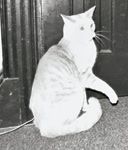
Photos 1: The tail wrap combined with facial and paw postures indicate this cat's desire for more distance.
In Photo 2 we see the focus of the cat's angst: a dog who, based on her head position and facial expression, is becoming convinced that the cat really doesn't desire her attentions. This photo is a terrific example of how multiple signaling systems can tell you not only what an animal is "saying" but how seriously they are communicating it. When all of the systems agree, there is little hesitancy in the animal's response.
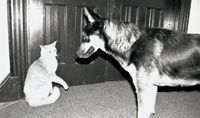
Photos 2: The tail wrap combined with facial and paw postures indicate this cat's desire for more distance.
In Photo 3, we see a series of cats all of whom have their tails either wrapped or tucked. While not actively fighting, none of these cats are engaged in active interaction. Here, the tail has functioned in a series of signals that not only indicated a lack of willingness to interact, but may have also functioned in the spacing of the animals.
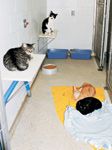
Photo 3: These cats signal a lack of willingness to interact, evidenced by their tail behaviors and obvious spacing.
In Photo 4, we have a complete interaction in process. This is a good reminder that behavior is a process, not an event. Yet, we can still glean substantial information from the tail postures of the animals involved. The orange Tabby looks very much like the cat in Photo 1; the tail is wrapped around the feet, and him ears and face have similar positions and expressions. The orange Tabby is not raising his paw; however, his signals are directed to the white cat with the orange head next to him. That object of his focus is studiously ignoring him, but her tail is also wrapped. The difference in the cat signaling lies with the rest of their body signals. The white cat is relatively content with the situation; the Tabby is not. In fact, of the cats in this photo, the Tabby is the one who doesn't fit. There is likely an interesting social history here, given the relatively relaxed or calm postures of the other cats. Notice that the Tabby is also thinner than the other cats. Anxious animals often lose weight. We have no information about the interactions between these cats, but if this photo were produced by a client, I would ask them about their interactions. When one animal is thin and the other is plump, some social factor is often worth investigating.
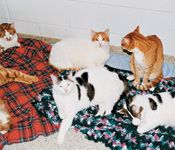
Photo 4: The orange Tabby might have behavior history judging by his posture compared to the other cats.
Photo 5 is a terrific example of the complexity of tail signaling. Cat tails often have disruptive coloring (bands or colors) that make their presence and movement in grass difficult to detect. Notice the obvious comfort and closeness of the group. Tails are raised to various heights in three of the cats. Fully raised tails signal a willingness to interact. Notice that the cat with the slightly lowered tail is leaving the group. The raised and gently waved tail is a very clear signal that allows other cats in the vicinity to decide whether they would like to interact. Notice that — despite the number of cats — none of them show any piloerection. All tail postures here are fluid and soft — a sure sign of a lack of social tension.
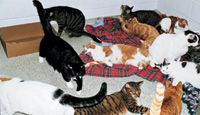
Photo 5: Fully raised tails signal a willingness to interact. All tail postures are fluid and soft, a sure sign of lack of social tension
A close up of the cats in the corner is shown in Photo 6. The orange Tabby is showing another tail and body posture that signals a close relationship in cats: his tail is curled against the brown Tabby and his feet are wrapped around the brown Tabby's face. Additionally, his body is fully outstretched, his eyes closed, and his face turned away from the brown Tabby. He has no concerns about threats here and is wholly comfortable in what would, in other circumstances, be a vulnerable position. Drs. Terry Curtis (University of Florida) and Sharon Crowell-Davis (University of Georgia) have noted that "preferred associates" will often wrap their tails around each other in any series of complex designs. The choice of which animal to affiliate with is an active choice here.
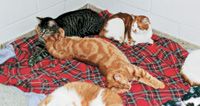
Photo 6: The vulnerable position of the Tabby signals deliberate ease and comfort.
Finally, in Photo 7, we see these same principles active in wild cats. These young cheetahs in a reserve in South Africa show tails clearly exposed and moving, complete with the disruptive coloration that is so useful in the veldt, and they are obviously playing. They are also signaling their willingness to continue that play.
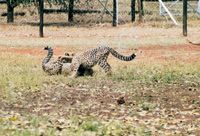
Photo 7: Similar tail behaviors can be seen in wild cats; here, two young cheetahs signal a willingness to continue playing.
Understanding these few simple associations can prevent many clients from misinterpreting their cat's behaviors. If clients learn to routinely assay the signals their cats are using in their interactions, they will note the early signs of social instability and will quickly seek veterinary help. Also, if clients understand that the signals displayed by cats in Photos 5 and 6 are sure signs of ease among known associates, behaviors can be used to gauge adjustment when new cats are added to the household. As with most complex social interactions, the earlier any difficulties are addressed, the faster they will improve.
What's your question?
Send your behavior-related questions to: DVM Newsmagazine, 7500 Old Oak Blvd., Cleveland, OH 44130. Your questions will be answered by Dr.Overall in upcoming columns.
Dr.Overall has given hundreds of national and international presentations and short courses and is the author of more than 100 publications on behavioral medicine and lizard behavioral ecology. She is a diplomate of the American College ofVeterinary Behavior (ACVB) and is certified by the Animal Behavior Society (ABS) as an Applied Animal Behaviorist.